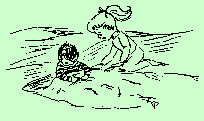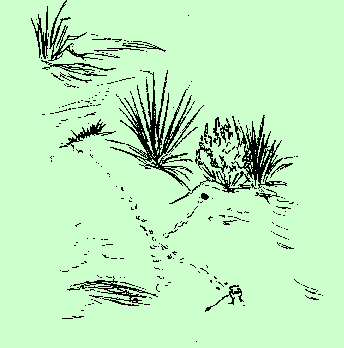|
Jericho Sand Dunes

 More than 100 people attended our pre-Easter camping trip to the sand
dunes west of Jericho, Utah, and enjoyed the many sights and sounds which
are unique to that area.
Among these were the low hoot of the Great Horned Owl, the call of
the coyote in the gray pre-dawn, the tracks in the sand of the kit fox,
kangaroo rats, mice and ground squirrel, the lacey trail of the darkling
beetle, the polished body of the Jerusalem Cricket (Child of the Earth,
or Sand Cricket) and the fluttering wings of a Painted Lady butterfly in
the camp firelight. The children of many families became friends quickly
and enjoyed the great "sand pile" from dawn to dark. Camping modes were
varied -- trailers, campers, buses and "old-fashioned tents" were used.
Leader Glenn Zophy's new blue and orange "Bug Proof" mountain tent did
get a couple of uninvited guests one night, but as Glenn said, "Well,
they can get in, but they can't get out!"
More than 100 people attended our pre-Easter camping trip to the sand
dunes west of Jericho, Utah, and enjoyed the many sights and sounds which
are unique to that area.
Among these were the low hoot of the Great Horned Owl, the call of
the coyote in the gray pre-dawn, the tracks in the sand of the kit fox,
kangaroo rats, mice and ground squirrel, the lacey trail of the darkling
beetle, the polished body of the Jerusalem Cricket (Child of the Earth,
or Sand Cricket) and the fluttering wings of a Painted Lady butterfly in
the camp firelight. The children of many families became friends quickly
and enjoyed the great "sand pile" from dawn to dark. Camping modes were
varied -- trailers, campers, buses and "old-fashioned tents" were used.
Leader Glenn Zophy's new blue and orange "Bug Proof" mountain tent did
get a couple of uninvited guests one night, but as Glenn said, "Well,
they can get in, but they can't get out!"


 Those who went "dune walking" were fascinated with fine sand and the
great variety of mammal, insect and bird tracks to be found. One very
puzzling track was discovered to be that of a female mallard when one
member reported seeing the duck fly early that morning. Owl pellets
revealed remains of insects and small mammals. A couple of lucky people
got pictures of a Great Horned Owl's nest with two white eggs. "Trade"
rat nests, burrows of kangaroo rats, ground squirrels and others were
noted. One burrow entrance was plugged with moist tender seedlings --
no doubt some animal's "fresh spring salad". Live traps captured small
animals so all might see them closely. The antelope ground squirrel,
( Citellus leucurus ) with its tail curled over its back revealing
the white ventral middle area, was voted interesting by the children.
Those who went "dune walking" were fascinated with fine sand and the
great variety of mammal, insect and bird tracks to be found. One very
puzzling track was discovered to be that of a female mallard when one
member reported seeing the duck fly early that morning. Owl pellets
revealed remains of insects and small mammals. A couple of lucky people
got pictures of a Great Horned Owl's nest with two white eggs. "Trade"
rat nests, burrows of kangaroo rats, ground squirrels and others were
noted. One burrow entrance was plugged with moist tender seedlings --
no doubt some animal's "fresh spring salad". Live traps captured small
animals so all might see them closely. The antelope ground squirrel,
( Citellus leucurus ) with its tail curled over its back revealing
the white ventral middle area, was voted interesting by the children.

 A study of the dunes shows the sand to be moving eastward at perhaps up to
three feet a year. Much of the surrounding area is overgrazed, and one
wonders if this abuse was releasing sand to be added to the dunes. A
variety of plants were also studied and many hope to return at a later
date to see them blossoming. Campfires with songs, skits and Indian
legends were enjoyed in the evenings. A dune walk by lantern light
Thursday evening, and star study on Friday night were interesting.
A study of the dunes shows the sand to be moving eastward at perhaps up to
three feet a year. Much of the surrounding area is overgrazed, and one
wonders if this abuse was releasing sand to be added to the dunes. A
variety of plants were also studied and many hope to return at a later
date to see them blossoming. Campfires with songs, skits and Indian
legends were enjoyed in the evenings. A dune walk by lantern light
Thursday evening, and star study on Friday night were interesting.

 A visit to Jasper Mountain on Saturday morning gave many an opportunity
for rock study. The afternoon tour of Eureka and the Tintic Mining area,
led and well organized by Alexander Blight, held the interest of 26
carloads. The tension and rush of modern living was forgotten in the
warmth of companionship and the joy of being in the great world of nature.
A visit to Jasper Mountain on Saturday morning gave many an opportunity
for rock study. The afternoon tour of Eureka and the Tintic Mining area,
led and well organized by Alexander Blight, held the interest of 26
carloads. The tension and rush of modern living was forgotten in the
warmth of companionship and the joy of being in the great world of nature.
Nature at the Sand Dunes
 The tiny "baby" scorpion which came around the Friday evening campfire
at the dunes, and the large adult which Glenn Zophy photographed, is a
common species in some Utah localities. While all scorpions around the
world have a poison sting at the tip of the abdomen, few are dangerous
to man. The above mentioned species has one interesting peculiarity.
The stinger in the female is much like that of other species of scorpions,
but that of the male is distinctive. A short distance back from the tip
of the sting is a "doughnut ring" or enlargement, which would seem to
limit the depth to which it can penetrate. There seems no advantage to
this structure, but if there is, why is the female not so equipped?
The tiny "baby" scorpion which came around the Friday evening campfire
at the dunes, and the large adult which Glenn Zophy photographed, is a
common species in some Utah localities. While all scorpions around the
world have a poison sting at the tip of the abdomen, few are dangerous
to man. The above mentioned species has one interesting peculiarity.
The stinger in the female is much like that of other species of scorpions,
but that of the male is distinctive. A short distance back from the tip
of the sting is a "doughnut ring" or enlargement, which would seem to
limit the depth to which it can penetrate. There seems no advantage to
this structure, but if there is, why is the female not so equipped?

 Shawn Platt captured a "Child of the Earth" (nina de tierra), a wingless
"cricket" which is a good burrower. It is also called the Sand Cricket
and Jerusalem Cricket. It feeds primarily on roots of plants and other
organic materials, but enjoys earthworms and grubs of flies and beetles.
It is not poisonous, as some persons believe. The generic name of the
animal is Stenopalmatus .
Shawn Platt captured a "Child of the Earth" (nina de tierra), a wingless
"cricket" which is a good burrower. It is also called the Sand Cricket
and Jerusalem Cricket. It feeds primarily on roots of plants and other
organic materials, but enjoys earthworms and grubs of flies and beetles.
It is not poisonous, as some persons believe. The generic name of the
animal is Stenopalmatus .


 Several species of beetles, spiders, scorpions, lizards, deer mice, pack
rat, kangaroo rat and numerous birds left interesting patterns of their
footprints and movements in the sand. Playing detective to discover which
of these animals made a certain track was a fascinating activity. Several
were positively identified when the process of the track-making by an
animal was observed.
Several species of beetles, spiders, scorpions, lizards, deer mice, pack
rat, kangaroo rat and numerous birds left interesting patterns of their
footprints and movements in the sand. Playing detective to discover which
of these animals made a certain track was a fascinating activity. Several
were positively identified when the process of the track-making by an
animal was observed.

 Homes of such creatures as tiny wasps and flies were observed in the form
of galls on rabbitbrush, shadscale, sage and other plants. These are odd
growths formed when the female insect involved lays an egg, and either it
or the hatched larva secretes a hormone to stimulate the plant to form an
odd-shaped mass or gall. The form is specific for the insect and plant
involved. Several people who opened one of these galls found fat white
grubs.
Homes of such creatures as tiny wasps and flies were observed in the form
of galls on rabbitbrush, shadscale, sage and other plants. These are odd
growths formed when the female insect involved lays an egg, and either it
or the hatched larva secretes a hormone to stimulate the plant to form an
odd-shaped mass or gall. The form is specific for the insect and plant
involved. Several people who opened one of these galls found fat white
grubs.

 Live traps set out by LeRoy Behling and Glenn Zophy captured kangaroo rats
and deer mice. These make pets as pleasant as cats or dogs, and with proper
kindly care, they thrive very well in a schoolroom free from dangers of
predation by owls, hawks or coyotes. Bill Long captured an antelope ground
squirrel in his trap, which was given to LeRoy Behling to photograph and
then to be released. These animals are too shy to make good schoolroom
pets.
Live traps set out by LeRoy Behling and Glenn Zophy captured kangaroo rats
and deer mice. These make pets as pleasant as cats or dogs, and with proper
kindly care, they thrive very well in a schoolroom free from dangers of
predation by owls, hawks or coyotes. Bill Long captured an antelope ground
squirrel in his trap, which was given to LeRoy Behling to photograph and
then to be released. These animals are too shy to make good schoolroom
pets.

 Even though the winds blow the sands at will, the numerous turret-building
spiders prepare chimney-like structures in the sands, which are kept open
efficiently. Running over the sands, but most common at the edge of the
dunes, were numerous wolf spiders (so named from their behavior of running
down their prey). They build no snares as do the orb weavers and the black
widow. The female carries the egg case attached to the end of her abdomen.
Even though the winds blow the sands at will, the numerous turret-building
spiders prepare chimney-like structures in the sands, which are kept open
efficiently. Running over the sands, but most common at the edge of the
dunes, were numerous wolf spiders (so named from their behavior of running
down their prey). They build no snares as do the orb weavers and the black
widow. The female carries the egg case attached to the end of her abdomen.
 -- by Dorothy K. Platt
-- by Dorothy K. Platt

|
|

